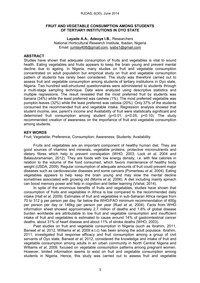FRUIT AND VEGETABLE CONSUMPTION AMONG STUDENTS OF TERTIARY INSTITUTIONS IN OYO STATE
Покупка
Основная коллекция
Издательство:
Редакция журнала RJOAS
Год издания: 2014
Кол-во страниц: 6
Дополнительно
Скопировать запись
Фрагмент текстового слоя документа размещен для индексирующих роботов
RJOAS, 6(30), June 2014
FRUIT AND VEGETABLE CONSUMPTION AMONG STUDENTS OF TERTIARY INSTITUTIONS IN OYO STATE
Layade A.A., Adeoye I.B., Researchers
National Horticultural Research Institute, Ibadan, Nigeria Email: jumlay408@gmail.com, iyabs1@gmail.com
ABSTRACT
Studies have shown that adequate consumption of fruits and vegetables is vital to sound health. Eating vegetables and fruits appears to keep the brain young and prevent mental decline due to ageing. In Nigeria, many studies on fruit and vegetable consumption concentrated on adult population but empirical study on fruit and vegetable consumption pattern of students has rarely been considered. The study was therefore carried out to assess fruit and vegetable consumption among students of tertiary institutions in Oyo state, Nigeria. Two hundred well-structured questionnaires were administered to students through a multi-stage sampling technique. Data were analyzed using descriptive statistics and multiple regressions. The result revealed that the most preferred fruit by students was banana (34%) while the least preferred was cashew (1%). The most preferred vegetable was pumpkin leaves (32%) while the least preferred was celosia (20%). Only 37% of the students consumed the recommended fruit and vegetable intake. Regression analysis showed that student income, sex, parent’s income and Availability of fruit were statistically significant and determined fruit consumption among student (p<0.01, p<0.05, p<0.10). The study recommended creation of awareness on the importance of fruit and vegetable consumption among students.
KEY WORDS
Fruit; Vegetable; Preference; Consumption; Awareness; Students; Availability.
Fruits and vegetables are an important component of healthy human diet. They are good sources of vitamins and minerals, vegetable proteins, protective micronutrients and dietary fibres which help to prevent constipation (WHO, 2003, Lock et al, 2004 and Balasubramanian, 2012). They are foods with low energy density, i.e. with few calories in relation to the volume of the food consumed, which favors maintenance of healthy body weight (USDA, 2009). Regular consumption of adequate amounts of fruit could prevent major diseases such as cardiovascular diseases and some cancers (Pomerleau et al, 2004). Eating vegetables appears to help keep the brain young and may slow the mental decline sometimes associated with growing old (Morris et al, 2006). A diet including mainly spinach can boost memory power and help in cognition and better learning (Vishal, 2014).
In spite of the enormous benefits of fruits and vegetables, studies have shown that consumption of fruits and vegetables in Africa is low compared to the recommended daily intake (Hall et al, 2009). Estimates of fruit and vegetables in sub-Saharan Africa ranges from 70 to 312 g per person per day, far below the WHO/FAO minimum recommendation of 400g per person per day or 146kg per person per year (Ruel et al, 2004). Facts from WHO information sheet showed approximately 2.7 million of deaths and 1.8% of global disease burden worldwide are attributable to low fruit and vegetable consumption and insufficient intake of fruit and vegetables is estimated to cause around 14% of gastrointestinal cancer deaths, about 31% of heart disease and about 11% of stroke deaths (WHO, 2003).
Past studies on fruit and vegetable consumption in Nigeria (such as Ibrahim, 2011, Banwat et al, 2012, Williams et al, 2009 e.t.c) has been among the adult populace. Ibrahim, 2011, investigated fruit response efficacy and fruit consumption among a group of civil servants of Oyo state, Banwat et al, 2012, considered the knowledge and intake of fruit and vegetable consumption among adults in an urban community in North Central Nigeria and Williams et al, 2009, focused on vegetable consumption patterns among pregnant women. However, limited information seems to exist on fruit and vegetable consumption among students in Nigeria. Hence, this study was carried out to assess fruit and vegetable
3


